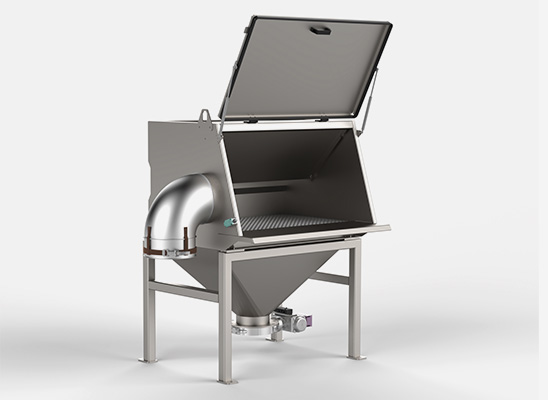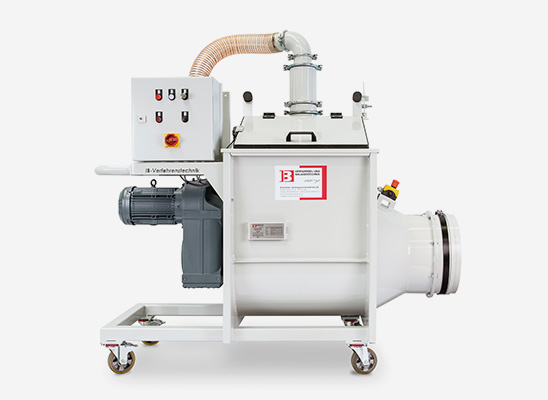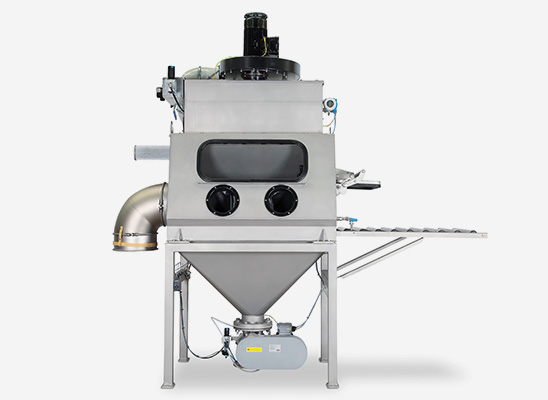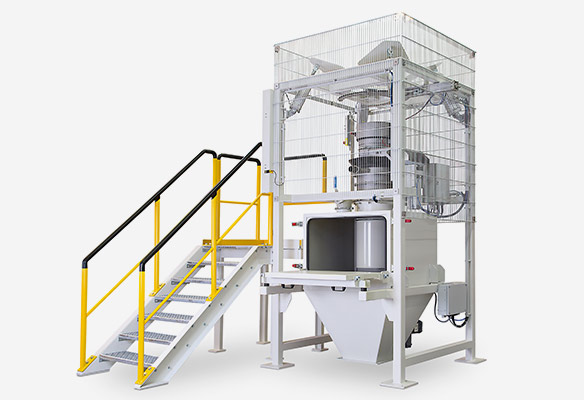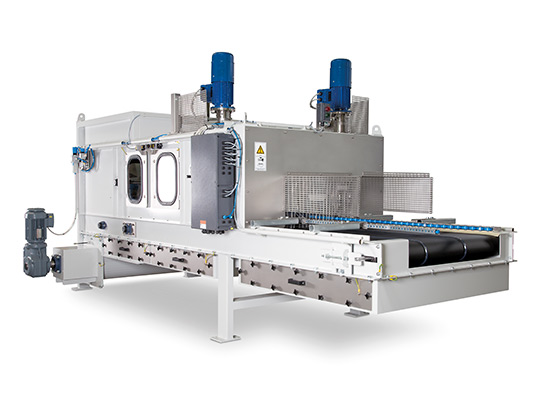



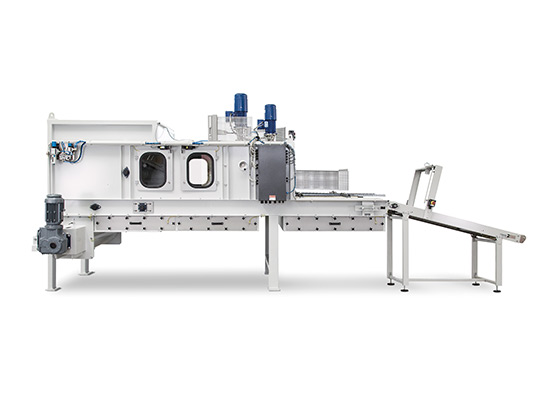

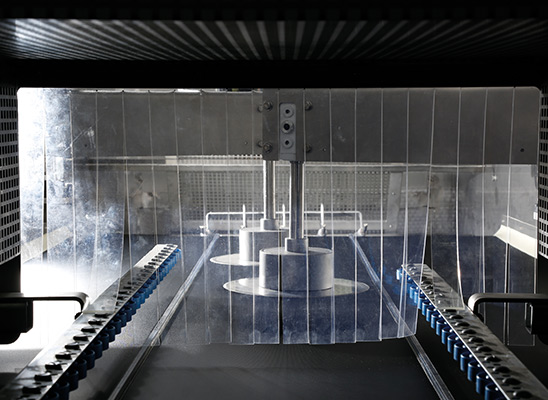



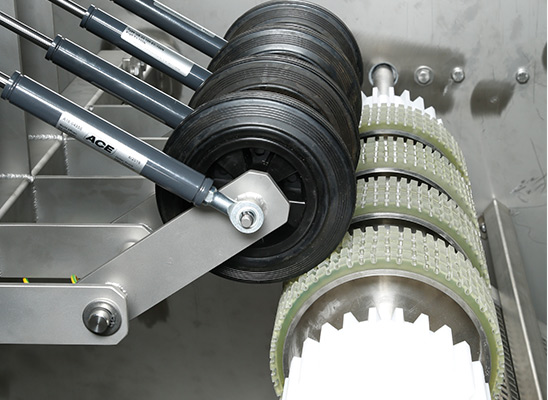

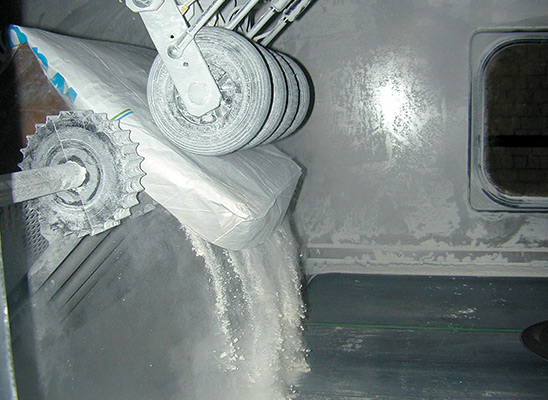

Bag emptying machines
The production process’s appetite for powders and granulates can be so great that new paper or plastic bags are constantly being opened and emptied. With the automated bag emptying system from IB Verfahrens- und Anlagentechnik, up to 600 bags per hour can be processed automatically. Complete emptying is carried out with minimal dust and the material is handled in a gentle manner. The bags are therefore not torn open, but cut open at the sides by circular blades. Only one person is needed to operate the machine.
Facts that will convince you
- Loading and operation by just one person
- For powders and granulates with good flow properties
- Bag sizes up to max. 800 mm length and 400 mm width
- Bags made of paper, plastic film and combinations
- Integrated control system with connection to PLC
- Customer-specific adaptations
- Top-mounted filter with pneumatic cleaning and fan
- Connection to external dedusting unit
- Permanently installed empty bag compactor
- Working and operating platforms
- Depalletising robot, pallet lifting table, vacuum lifter
- ATEX version
Product description
The automated bag emptying machine works with two round knives that cut the bags open cleanly on three sides during the cycle without breaking them. The swivelling arrangement of the cutting discs enable bags of various sizes and a wide range of lengths and widths to be emptied without having to adjust the machine.
Roller tracks to guide the pallets are available for user-friendly bag insertion. Pallet lifting tables or vacuum bag lifters can be added to the automated bag emptying system in order to make insertion easier.
The product discharge point on the emptying machine can be positioned directly above the filling connections on production machines or HGVs. The bag emptying machine can be raised up on a frame in order to set it up above process inlet openings and to accommodate peripheral devices.
All areas in which it is possible to reach into the machine are provided with safety switches and light barriers in order to protect the operating staff. Of course, the automatic bag emptying system meets the requirements of the ATEX directive.
Materials
The parts that do not come into contact with the product such as frames can be made of stainless steel and painted or galvanised steel.
The elements that come into contact with the product are made of bright rolled 1. 4301 (V2A) as standard. Other materials can also be used upon request.
Functional description
Loading the machine
The pallet with the bags to be emptied is placed next to the conveyor belt. A roller track can be used to position the pallet in the action area. The operator or the depalletising robot places the bags one after the other on the conveyor belt. The bags are positioned correctly via side guise rails and moved through a strip door into the machine.
Opening the bags
The conveyor belt conveys the bag against two electrically-driven round knives that rotate very quickly. The knives are arranged one after the other and first cut the bag open on the short side. Once a preset counter pressure is reached, the knives turn to the side and cut the bag’s two sides open. The rear edge is not cut. We would like to emphasise that the bag is cut open and not ripped. Therefore, the bag is not destroyed and the product is not contaminated with bag residues.
Emptying the bags
The bag that has been cut open remains on the conveyor belt. At the end of the revolving conveyor belt, a sensor-controlled lifting fork lifts the bag’s “lid” upwards and transfers it to the bag discharge device. In this process step, the product falls out of the bag into the hopper that is below it. The bags are therefore emptied with virtually no residue.
Discharging the emptied bags
The bag discharge comprises several rollers that are arranged in parallel and that turn in opposite directions. The rollers are after the conveyor belt and above the product discharge. The lifting fork places the empty bag between the rollers. The rollers convey the bag upwards. They fall out of the discharge shaft and directly into the empty bag compactor. The emptying procedure is supported by rollers again.
Product discharge
The product is transferred to the next process step below the machine. The transfer can be designed with various metering devices such as metering screws and cellular wheel sluices. A mechanical or pneumatic conveyor can also be added.
Downloads
Our individual customer solutions in the bag handling sector
Our systems differ as much as our customers’ requirements and almost always have an individual note. Each system is therefore unique.
We can use system modules to offer, design and produce numerous solutions quickly and in a reproducible manner. Furthermore, our range of modules increases continuously due to the requirements of our new customers.
The references section provides you with a selection of customer projects that have already been completed, along with notable special features.


